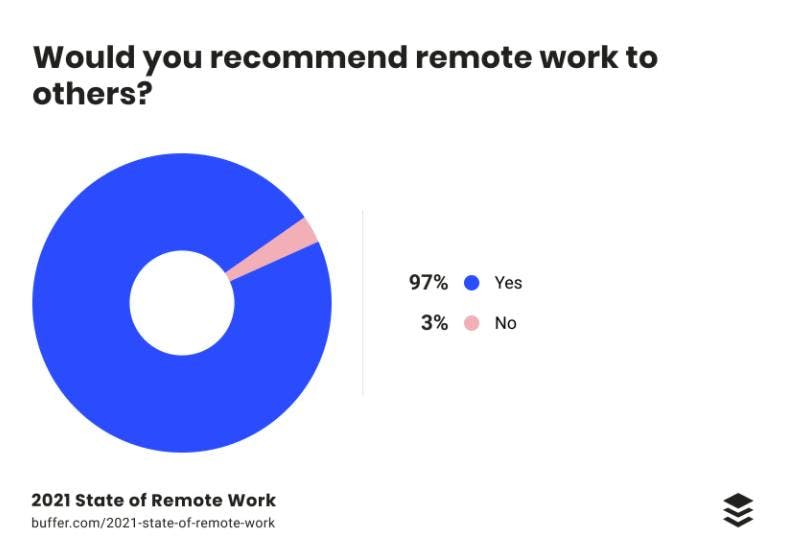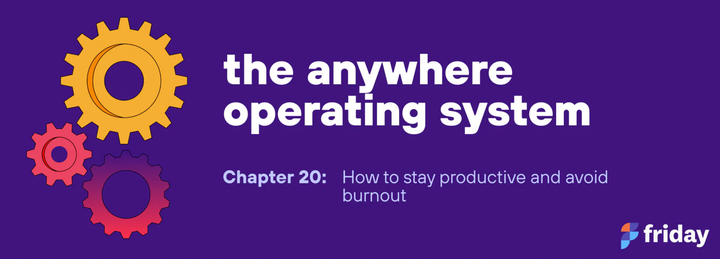Chapter 2: is working from anywhere a fad?

Major movements in society arrive like waves crashing on the beach. For the work-from-anywhere (WFA) movement, the wave was like a tsunami when COVID-19 arrived in early 2020. Our world changed overnight.
A huge wave is formed by a variety of factors – Wind. Underwater disturbances. Volcanic eruptions. Earthquakes. Similarly, the work-from-anywhere wave has several contributors too.
If we want to understand if the WFA shift is sustainable and truly the “future of work,” we need to dig beneath the surface and try to find what is causing the wave. That’s what the remainder of the chapter is about.
Don’t bet against network effects
The most important thing you should think about, as you plan for this new future of work, is to recognize that WFA has network-effect-like characteristics. For those unfamiliar with network effects, it’s a phenomenon where the strength of a product or movement strengthens as more people join.
For example, Facebook was not valuable when there were 100 students using it at Harvard. The Facebook network is much stronger and much more valuable with billions of people around the world using the platform.
We can see a similar dynamic at play with remote work. According to the Buffer State of Remote Work survey, 97% of respondents said that they would like to continue working remotely (at least some of the time).

Additionally, 97% of respondents would recommend remote work to others. Put simply, the people who experience this way of working don’t want to go back and they overwhelmingly recommend it to others.
As a leader, what are the implications here?
If you don’t adopt this new way of working, your hiring pool will get smaller over time as more people join the work-from-anywhere network. Some of your best employees will leave and go work for competitor who offers flexibility. Does this make you nervous?
The COVID-19 pandemic accelerated an existing shift
As you already know, the COVID-19 pandemic forced the desk-bound population to work from home for over a year. It can be difficult to separate the signal from the noise. Is this a permanent shift or a short-term impact from COVID? We’re going to examine what was happening before the COVID-19 pandemic started and see if these factors are still in motion today.
Another contributing factor is that you were probably already working in a distributed way before the pandemic. If you worked with coworkers in other offices, you were already working in a distributed way, but you could rely on the office to fill in the gaps and help you connect with your team.
What is creating the wave?
Now that we’ve mentioned the high-level principles, let’s get into the specific factors that accelerated the rise of distributed work.
1. Specialized talent & geographical constraints
The first factor is that people with specialized skills are in high demand, especially in major metros. There’s only so many people with a particular skill set in a given city.
This means that companies had a limited supply of candidates within driving distance from the office, which forced them to look elsewhere. At this point, the company has a couple options:
- Recruit from away, and convince them to move closer to the office
- Recruit from away and let them work-from-anywhere
It’s much easier to recruit if you give candidates a choice instead of forcing them to move. This is especially true if the potential hire has a spouse who works, a family, and roots in their community. It’s one thing to move as an individual; it’s another to move as a family.
Additionally, someone with a specialized skillset has leverage during negotiations. If the company is desperate enough to make a hire and a great candidate doesn’t want to move, the candidate can vote with their feet by not taking the job.
Before the COVID-19 pandemic, we saw this happen quite a bit with technical talent. I have no reason to believe this trend won’t continue after the pandemic subsides.
2. The rising cost of living
Before the COVID-19 pandemic, the cost of living soared in major cities, with no real increase in the value that was being provided to the residents. You paid for the same unit of housing, yet the price would continue to rise.
Take a look at the cost of a one-bedroom apartment in major cities around the United States before the pandemic hit:
- San Francisco - $3,546/mo median rent
- New York - $3,073/mo median rent
- Boston - $2,595/mo median rent
While it’s reasonable to expect people will still live in the city, it’s also fair to assume that some percentage of people would rather live elsewhere, with a dedicated home office, more space, and cheaper housing. Are you are willing to skip over talented people who don’t want to live near your office?
3. The commute
Another factor that drove the early growth of remote work was the increasing amount of time spent commuting. The average commute in the US was 27 minutes (one way). Since 2010, that number has grown by 2 minutes. While this doesn’t sound like a lot, the reality is that people were spending almost an hour a day doing something that they probably didn’t want to do. I remember when I lived in Boston, I would spend at least an hour a day squashed alongside people on the local subway. I hated it. It felt like an epic waste of time.
While there’s no problem with driving, listening to podcasts, and decompressing at the end of the work day, you might want to do something else, like hang out with your kids or friends. Maybe you decide to use the extra free time to learn a new skill or pursue a hobby?
As the pandemic subsides, I think it’s safe to assume that forcing a commute will be frowned upon. While some travel is fair, being forced to travel every day is a different story.
4. Millennials are growing up
Another contributor to the wave of working from anywhere is the reality that the largest group in the US labor force is millennials. What do we know about millennials? They are getting married later.
Why do we care? As this group settles down, they begin having kids; they may want a house in suburbia instead of a condo in the city.
Why does that matter? This matters because there’s a gravitational pull toward living further outside the city by the largest part of the workforce. This means people will be spending more time commuting if we go back to the way things were before COVID.
5. The pace of technological change
Technology continues to accelerate, especially if we look at the past few years. For example, some of the most popular tools for remote work were created after 2010 (Zoom in 2011, Slack in 2013, and Microsoft Teams in 2017).
As someone who’s been working on building remote work tools for years, many investors previously wrote off this category because they didn’t think the market was big enough. To be fair to them, it probably wasn’t. At least before 2020.
What this means for you is that we are going to see a lot of innovation over the next few years. There will be tons of remote work apps vying for your attention. Companies like Facebook will aggressively invest in virtual reality technology like Oculus to create the feeling of connection when working-from-anywhere.
6. The pioneers paved the way
In the late 2000s, forward-thinking companies paved the way and showed us how to work-from-anywhere. Basecamp and others forged a path for startups like Zapier, GitLab, InVision, and Automattic. These forward-thinking organizations have shown us that it’s possible to scale a company without an office as several of them now have over 1,000 employees (and growing!).
These early leaders love to teach and share what they learn. They write books, open-source their company handbooks, and teach classes. This public content and willingness to share has reduced the risks associated with remote work for newly formed startups, which accelerates adoption.
7. The office was designed for collaboration, not deep work
Finally, we have the reality that the office was built for a particular style of work that is focused on real-time collaboration and spontaneous interactions with coworkers. The open-office floor plan is intentionally designed to encourage random collisions at the water-cooler. While this is okay in small doses, it is not conducive for doing deep, thoughtful work.
I remember when I worked at the office, I would have to put on noise-cancelling headphones to “tell” my coworkers that I was trying to get stuff done. Even then, people would tap me on the shoulder with a question, which drove me nuts. At times, I would need to ask my boss if I could leave the office to do heads-down work.
But will it stick?
Back in 2013, Yahoo ended its remote work policy and required that employees come back into the office. A reasonable question to ask is: “is what happened in 2013 a sign of things to come?” Is working from anywhere a short-term trend caused by COVID, or a lasting change?
My hope is that by listing out the factors that have accelerated the work-from-anywhere shift, you can come to your own conclusions. If you look at the factors causing the wave, do you expect them to grow or subside in the future? Do you expect the rate of technological change to continue or stop? Do you expect that people will opt into a commute again every day of the week or not?
If you expect this shift to continue, you should keep reading the next chapter, we were discuss the office vs. remote :)


